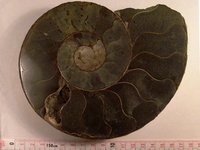Ammonite
|
|
This article is about the marine animal. For the novel see Ammonite (novel), for the Biblical people, see Ammon (nation), and for the ancient Egyptian god see Ammon.
| Ammonites Conservation status: Fossil | ||||||||
|---|---|---|---|---|---|---|---|---|
 A large ammonite, 0.6 metre (2 feet) across, outside the Portland Museum, Portland, England. | ||||||||
| Scientific classification | ||||||||
| ||||||||
| Orders and Suborders | ||||||||
Ammonites are an extinct group of marine animals (subclass Ammonoidea) in the phylum Mollusca and class Cephalopoda. Their closest living relative is probably the modern nautilus, whom they resemble. Their fossil shells have the form of flat spirals (though there are some rarer non-spiraled forms, called heteromorphs) and are responsible for the animals' name as they somewhat resemble a tightly coiled ram's horn (the god Ammon was commonly depicted as a man with ram's horns). Plinius the Elder (died 79 AD near Pompeii) called fossils of these animals ammonis cornua, "horn of Ammon." Often the name of ammonite species ends in ceras, Greek (κέρας) for "horn" (e.g. Pleuroceras).
| Contents |
Classification
Ammonites first appeared in the late Silurian to early Devonian (~400 million years ago) and became extinct at the close of the Cretaceous along with the dinosaurs (65 million years ago). The classification of ammonites is based in part on the ornamentation and structure of their shells, which divide this subclass into three orders and eight known suborders. Unlike the nautiloids, all of which have gently curving sutures, the suture line between the chamber wall and the outer ammonite shell was folded, forming saddles (or peaks) and lobes (or valleys). Here they are listed from most primitive to more advanced:
Orders and suborders:
- Goniatitida (Devonian to Permian) - round saddles, pointed lobes
- Anarcestina (Devonian only)
- Clymeniina (Upper Devonian only)
- Goniatitina (Devonian to Upper Permian)
- Ceratida (Carboniferous to Triassic) - round saddles, serrated lobes
- Prolecanitina (Upper Devonian to Upper Triassic)
- Ceratitina (Permian to Triassic)
- Ammonitida (Permian to Cretaceous) - folded saddles and lobes, fractal patterns
- Phylloceratina (Lower Triassic to Upper Cretaceous)
- Ammonitina (Lower Jurassic to Upper Cretaceous)
- Lytoceratina (Lower Jurassic to Upper Cretaceous)
- Ancyloceratina (Upper Jurassic to Upper Cretaceous) - the heteromorph ammonites
Life
Ammonite_Jeletzkytes.jpg
Because ammonites and their close relatives are extinct, little is known about their way of life. Their soft body parts are practically never preserved in any detail. Nonetheless, a lot has been worked out by examining ammonite shells and by using models of these shells in water tanks.
Most ammonites probably lived at the surface of ancient seas; this is suggested by the fact that their fossils are often found in rocks that were laid down under conditions where no benthic (bottom-dwelling) life is found. Many of them are thought to have been good swimmers with flattened, discus-shaped, streamlined shells (such as Oxynoticeras), although some were less effective swimmers and were likely to have been bottom dwellers. Ammonites probably preyed on fishes and crustaceans and were themselves preyed upon by marine reptiles (such as Mosasaurs). Fossilized shells are sometimes found showing teeth marks from such attacks.
Shell anatomy and diversity
Basic shell anatomy
The chambered part of the ammonite shell is called a phragmocone. The phragmocone contains a series of progressively larger chambers, called camerae (sing. camera) that are divided by thin walls called septa (sing. septum). Only the last and largest chamber, the body chamber, was occupied by the living animal. As it grew, it added newer and larger chambers to the open end of the coil.
A thin living tube called a siphuncle passed through the septa, extending from the ammonite's body into the empty shell chambers. Through an osmotic process, the ammonite emptied water out of and secreted gas into these shell chambers. This enabled it to control the buoyancy of the shell.
A primary difference between ammonites and nautiloids is that the siphuncle of ammonites runs along the inside of the outer axis of the shell, while the siphuncle of nautiloids runs through the center of the septa and camerae.
Sexual dimorphism
One feature found in shells of the modern nautilus is the variation in the size of the shell according to the gender of the animal, the shell of the male being slightly smaller than that of the female. This sexual dimorphism is thought to be an explanation to the variation in size of certain ammonite shells of the same species, the larger shell (called a macroconch) being female, and the smaller shell (called a microconch) being male. This is thought to be because the female required a larger body size for egg production. A good example of this sexual variation is found in Bifericeras from the early part of the Jurassic period of Europe.
It is only in relatively recent years that the sexual variation in the shells of ammonites has been recognized. The macroconch and microconch of one species were often previously mistaken for two closely related but different species occurring in the same rocks. However, these "pairs" were so consistently found together that it became apparent that they were in fact sexual forms of the same species.
Variations in shape
The majority of ammonites have a shell that is a planispiral flat coil, but some have a shell that is partially uncoiled, partially coiled and partially straight (as in Australiceras), nearly straight (as in baculites and belemnites), or coiled helically - superficially like that of a large gastropod (as in Turrilites and Bostrychoceras). These partially uncoiled and totally uncoiled forms began to appear during the early part of the Cretaceous and are known as heteromorphs.
Perhaps the most extreme and bizarre looking example of a heteromorph is Nipponites, which appears to be a tangle of irregular whorls lacking any obvious symmetrical coiling. However, upon closer inspection the shell proves to be a three-dimensional network of connected "U" shapes. Nipponites occurs in rocks of the upper part of the Cretaceous in Japan and the USA.
Ammonites vary greatly in the ornamentation of their shells. Some may be smooth and relatively featureless, except for growth lines, and resemble that of the modern nautilus. In others various patterns of spiral ridges and ribs or even spines are shown. This type of ornamentation of the shell is especially evident in the later ammonites of the Cretaceous.
The aptychus
Like the modern nautilus, many ammonites were probably able to withdraw their body into the living chamber of the shell and developed either a single horny plate or a pair of calcitic plates with which they were able to close the opening of the shell. The opening of the shell is called the aperture. The plates are collectively termed the aptychus or aptychii in the case of a pair of plates, and anaptychus in the case of a single plate. The aptychus were identical and equal in size.
Ammonite_Asteroceras.jpg
Anaptychi are rare as fossils. They are found in ammonites from the Devonian period through those of the Cretaceous period.
Aptychi only occur in ammonites from the Mesozoic era and are normally found detached the shell and are rarely preserved in place. Still, sufficient numbers have been found closing the apertures of fossil ammonite shells as to leave no doubt as to their intended purpose. (This long standing and wide-spread interpretation of the function of the aptychus has recently been disputed. The latest studies suggest that the apatychus may have in fact formed part of a special jaw apparatus).
Large numbers of detached aptychi occur in certain beds of rock (such as those from the Mesozoic in the Alps). These rocks are usually accumulated at great depths. The modern nautilus lacks any calcitic plate for closing its shell, and none has been found in any of the extinct nautiloids. It does, however, have a leathery head shield it uses to cover the opening when it retreats inside.
There are many forms of aptychus, varying in shape and the sculpture of the inner and outer surfaces, but because they are so rarely found in position within the shell of the ammonite it is unclear as to which species of ammonite many aptychi belong.
Size
Few of the ammonites occurring in the lower and middle part of the Jurassic period reach a size exceeding 23 centimetres (9 inches) in diameter. Much larger forms are found in the later rocks of the upper part of the Jurassic and the lower part of the Cretaceous, such as Titanites from the Portland Stone of Jurassic of southern England, which is often 53 centimetres (2 feet) in diameter, and Pachydiscus seppenradensis of the Cretaceous period of Germany, which is the largest known ammonite sometimes reaching 2 metres (6.5 feet) in diameter. The largest known North American ammonite is Parapuzosia bradyi from the Cretaceous with specimens measuring 137 centimetres (4.5 feet) in diameter.
Ammonite distribution
HoloscaphitesAmmonite.jpg
Starting from the late Silurian, ammonites were extremely abundant, especially in the Mesozoic seas. Many genera evolved and ran their course quickly, becoming extinct in a few million years. Due to their rapid evolution and widespread distribution, ammonites are useful for geologists and paleontologists for biostratigraphy. They are excellent index fossils, and it is often possible to link the rock layer in which they are found to specific geological time periods.
IridescentAmmonite.jpg
When ammonites are found in clays their original mother-of-pearl coating is often preserved. This type of preservation is found in ammonites such as Hoplites from the Cretaceous Gault clay of Folkestone in Kent, England.
The Cretaceous Pierre Shale formation of the United States and Canada is well known for the abundant ammonite fauna it yields, including Baculites, Placenticeras, Scaphites, Hoploscaphites, and Jeletzkytes, as well as many uncoiled forms. Many of these also have much or all of the original shell still intact.
Other fossils, such as many found in Madagascar, display iridescence. These iridescent ammonites are often of gem quality when polished.
The ammonites survived several major extinction events, with often only a few species surviving. But each time, this handful would diversify into a multitude of forms. Ammonites fossils become less abundant during the upper part of the Cretaceous, and none survive into the Cenozoic era. The last surviving lines died out about 65 million years ago along with the dinosaurs in the Cretaceous-Tertiary extinction event.
Trivia
In medieval times, ammonites were believed to be petrified snakes. They were frequently fitted with carved snake-like heads and sold to pilgrims.
References and further reading
- Neal L Larson, Steven D Jorgensen, Robert A Farrar and Peter L Larson. Ammonites and the other Cephalopods of the Pierre Seaway. Geoscience Press, 1997.
- Monks, Neale and Palmer, Phil. Ammonites. Natural History Museum, 2002.
- Walker, Cyril and Ward, David. Fossils. Dorling, Kindersley Limited, London, 2002.
- A Broad Brush History of the Cephalopoda (http://is.dal.ca/~ceph/TCP/evolution.html) by Dr. Neale Monks, from The Cephalopod Page.
- Ammonite maturity, pathology and old age (http://is.dal.ca/%7Eceph/TCP/ammonage.html) By Dr. Neale Monks, from The Cephalopod Page. Essay about the life span of Ammonites.
- Cretaceous Fossils Taxonomix Index for Order Ammonoitida (http://www.cretaceousfossils.com/invertebrates/ammonites/ammonites_index.htm)
See also
- Fossils and the geological timescale
- Belemnoidea
- Nautiloidea
- Ammolite - a gemstone formed from fossil ammonite shells.
External links
- Photos of Ammonites at Lyme Regis, UK (http://y2u.co.uk/&002_Images/Lyme%20Regis%20Fossils%20%2001.htm)de:Ammoniten
fr:Ammonite he:אמוניטים it:Ammonoidea ja:アンモナイト nl:Ammoniet pl:Amonity (biologia)

